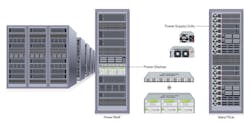The State of Data Center Sustainability
Amid rapidly rising demand for digital platforms and services in recent years, the data center sector has been in growth mode. But as businesses, economies and consumers become ever dependent on digital infrastructure, concerns for environmental sustainability are accelerating, with data center operators beginning to measure all aspects of their operations in a race to reduce carbon emissions.
Although data centers have become much more sustainable in the past decade, the rising demand for data has been so spectacular that data centers have inevitably become some of the world’s biggest consumers of power. In fact, evidence suggests that data centers account for more than two per cent of global energy consumption – equivalent to the aviation industry – which is projected to rise to eight per cent by 2030 if left unchecked.
While strides have been made to keep pace with this digital growth, designing, developing, and operating sustainable data centers remains one of the biggest challenges facing developers, co-location operators, global cloud computing providers and hyperscalers alike.
Considering this increased emphasis on sustainability, data centers must reduce their carbon footprint while continuing to support the rising demand for data.
Determining a Data Center’s Carbon Footprint
The carbon footprint of a data center can be coarsely categorized into three classes: from the manufacture of the data center and its purchased equipment, from daily operations, and from end-of-life disposal of equipment and decommissioning of the data center.
Hardware and infrastructure equipment make up most of a data center’s carbon output. While new data centers look to address sustainability challenges from inception, legacy data centers continue to consume enormous amounts of energy. In the coming years, this legacy infrastructure will need decarbonizing, requiring both investment and innovation to drive energy efficiency while remaining in operation.
Moving to Net Zero
One obvious solution for the future of sustainable data centers is moving to net zero, forming the basis of clean energy infrastructure that is resilient, and environmentally-friendly for the next generation of the digital economy.
As major economies look to, or are in the process of passing net zero emissions laws, the data center industry has made its own pledge – led by companies such as Facebook, Google, and Microsoft – committing to ensuring that three-quarters of energy used by their data center facilities must be renewable or carbon-free by 2025, and realize complete climate neutrality by 2030.
But for data centers to achieve carbon neutral status, they must meet ambitious measurable targets.
When it comes to benchmarking the carbon efficiency of a data center, Carbon Usage Effectiveness (CUE) is the first widely adopted metric. Developed by The Green Grid, CUE is the ratio of the total CO2 emissions caused by total data center energy consumption to the energy consumption of IT equipment.
Despite capturing carbon emissions incurred by electricity consumption, CUE is becoming a less representative metric for the sustainability of a data center as more operators resort to off-site renewable energy like Power Purchase Agreements (PPA) to offset their large amount of electricity consumption. And we’re seeing the likes of Facebook and Google, turn their attention to major energy projects to completely decarbonize their electricity use through Carbon Free Energy (CFE) generation from renewable sources.
Achieving Sustainability
The transition to a more sustainable industry requires a shift in the way data infrastructure is planned, designed, and built. By establishing proactive, resource-efficient facilities built for ultra-efficiency from the outset, operators can ensure sustainable operation, maintenance, and refurbishment.
The electricity drawn from IT and cooling systems accounts for approximately 86 percent of total energy consumption in a data center. Adopting a holistic approach that addresses environmental, financial, compliance, and efficiency considerations, can successfully help safeguard the environment while lowering long-term operating costs for emerging and technology-driven markets. The adoption of open standards such as the Open Rack specification from the Open Compute Project (OCP), contribute to improving the power consumption efficiency – and therefore sustainability – of data centers.
Brian Korn is the Vice President of Data Center Computing at Advanced Energy and brings broad experience in embedded power solutions for data center computing, hyperscale, telecom and network products. Advanced Energy’s OCP compliant platform is a key enabler in achieving sustainability goals, providing support for the digital economy and CAPEX/OPEX savings to hyperscale and enterprise data centers. Contact them to learn more.






